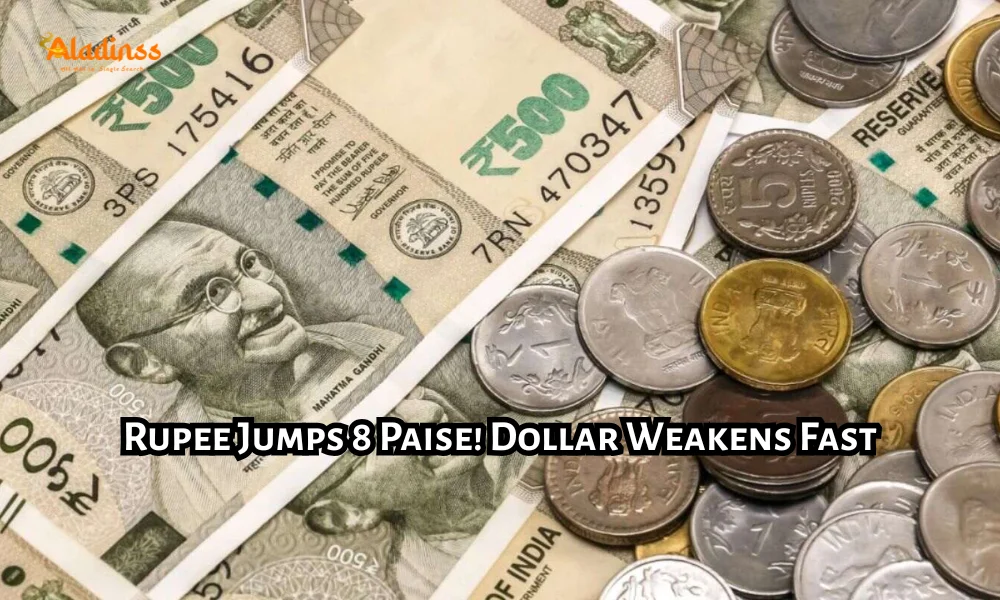Rupee Rises 8 Paise to 88.62 Against Dollar in Early Trade

Indian Rupee Gains 8 Paise to 88.62 Against US Dollar in Early Trade
The Indian rupee strengthened by 8 paise to reach 88.62 against the US dollar during Thursday’s early trading session in Mumbai. This modest recovery came on the back of a softening American currency in global markets and declining crude oil prices, creating a favorable environment for the domestic unit.
Traders noted that upbeat domestic stock market performance provided additional support to the rupee. However, sustained outflows by foreign institutional investors capped sharper gains. The currency opened at 88.51, touched a high of 88.49, and was last seen trading at 88.62 marking a clear improvement from its previous close.

Key Factors Driving Rupee Appreciation on November 6
The dollar index, a benchmark measuring the greenback’s value against six major currencies, dipped 0.16 percent to 99.90 in early Asian hours. This weakness stemmed from mixed economic signals from the United States, including cautious commentary from Federal Reserve officials and anticipation surrounding upcoming inflation data.
Meanwhile, Brent crude oil a critical import for India saw a marginal uptick of 0.17 percent to $63.63 per barrel. Though slightly higher, the price remains near multi-month lows, easing pressure on India’s trade deficit and current account balance. Lower energy costs typically bolster the rupee by reducing import bills.
Domestic equity benchmarks reflected investor optimism. The BSE Sensex surged 321.81 points or 0.39 percent to 83,780.96, while the NSE Nifty advanced 57.05 points or 0.22 percent to 25,654.70. Strong buying in banking, IT, and consumer goods stocks fueled the rally, indirectly supporting currency stability.
FII Selling Caps Rupee’s Upside Potential
Despite positive cues, foreign institutional investors (FIIs) continued their selling streak. Data from the National Stock Exchange revealed net equity outflows of ₹1,067.01 crore on Tuesday the last trading day before the Prakash Gurpurab holiday closure on Wednesday. Persistent FII divestment has been a drag on the rupee throughout the festive season.
Analysts attribute this trend to global risk aversion, higher U.S. bond yields, and uncertainty ahead of the U.S. presidential election outcome. Though the rupee has held above the psychological 88.70 mark, sustained capital flight remains a concern for policymakers at the Reserve Bank of India (RBI).
The RBI has been actively managing volatility through dollar sales and swaps. Its comfortable foreign exchange reserves exceeding $700 billion provide ample firepower to intervene if the rupee faces sharp depreciation pressure in the coming weeks.
Rupee Performance in Recent Sessions
Tuesday saw the rupee close 7 paise higher at 88.70, supported by similar factors a weaker dollar and stable oil prices. The currency has traded within a narrow band of 88.45 to 88.80 over the past week, reflecting cautious two-way flows in the interbank forex market.
Year-to-date, the rupee has depreciated by approximately 6.2 percent against the dollar, underperforming several Asian peers like the Indonesian rupiah and Thai baht. However, recent stability signals resilience amid global headwinds, including geopolitical tensions and commodity price fluctuations.
Currency strategists expect the rupee to consolidate between 88.30 and 89.00 in the near term, barring major external shocks. A breakthrough below 88.50 could invite fresh buying interest from exporters and RBI, while a sustained move above 89.00 might trigger defensive interventions.
Global Currency Movements and Dollar Weakness
The U.S. dollar faced broad-based selling as traders positioned for potential policy shifts post-election. The euro strengthened to $1.0780, while the Japanese yen held firm near 152.80. Emerging market currencies, including the Indian rupee, benefited from this risk-on sentiment.
Market participants are closely monitoring the Federal Reserve’s interest rate decision later this month. Any hint of a pause in rate hikes could further depress the dollar, offering additional tailwinds to the rupee and other EM currencies.
In contrast, the British pound and Australian dollar also posted gains, reflecting improved global growth expectations. Gold prices, a traditional safe-haven, eased slightly to $2,620 per ounce, indicating reduced flight-to-safety demand.
Impact of Crude Oil Prices on Indian Economy
India imports over 80 percent of its crude oil requirements, making energy costs a pivotal driver of currency valuation. The current Brent price below $65 per barrel translates to significant savings on the import bill estimated at nearly $2 billion monthly compared to peak levels seen in 2022.
This windfall supports fiscal consolidation efforts and helps contain inflationary pressures. Retail fuel prices have remained stable for over 18 months, boosting consumer sentiment and discretionary spending both positive for economic growth and rupee stability.
However, analysts caution that any escalation in Middle East tensions could reverse this trend. Supply disruptions from key producers like Saudi Arabia or Iran would push oil prices higher, exerting downward pressure on the rupee and widening the trade deficit.
Domestic Equity Markets Show Resilience
The Indian benchmark indices opened firmly in positive territory, led by gains in heavyweight stocks like HDFC Bank, Reliance Industries, and Infosys. Midcap and smallcap segments also participated, with the BSE Midcap index rising 0.45 percent.
Sectoral rotation was evident, with realty, metals, and auto stocks leading advancers. Defensive plays like FMCG and pharmaceuticals lagged slightly, indicating rotational buying rather than broad risk aversion.
Advance-decline ratio stood healthy at 3:2 on the BSE, with over 2,100 stocks trading in the green. Trading volume picked up in the second hour, suggesting institutional participation alongside retail investors.
RBI’s Role in Currency Management
The Reserve Bank of India continues its calibrated approach to forex intervention. Unlike aggressive dollar purchases seen in 2021–22, the central bank now prioritizes volatility containment over targeting a specific exchange rate level.
Recent measures include forward dollar sales and liquidity absorption through variable rate repo auctions. These tools help anchor market expectations and prevent speculative attacks on the rupee during periods of heightened uncertainty.
The RBI’s forex reserves rose by $1.5 billion in the week ending October 31, underscoring proactive reserve accretion. This buffer equates to over 12 months of import cover among the highest globally and enhances investor confidence in India’s external sector resilience.
Outlook for Rupee in Coming Weeks
Currency experts predict range-bound trading in the short term. Support is seen near 88.40–88.50, backed by exporter dollar sales and RBI presence. Resistance lies at 88.80–89.00, where importers and speculative shorts may emerge.
Key events to watch include U.S. CPI data, India’s industrial production numbers, and corporate earnings from major banks. Any positive surprise on inflation or growth could trigger a relief rally in the rupee toward 88.20 levels.
Longer-term, structural reforms, robust FDI inflows, and a narrowing current account deficit position the rupee for gradual appreciation. Analysts at leading brokerages forecast a median value of 87.50 by March 2026, assuming stable global conditions.
How Exporters and Importers Are Responding
Exporters, particularly in IT, pharmaceuticals, and textiles, are hedging receivables at current levels to lock in profitability. A rupee below 89.00 remains favorable for competitiveness in global markets, especially against Chinese and Vietnamese peers.
Importers of electronics, machinery, and chemicals are accelerating payments to avoid potential cost escalation if the rupee weakens further. Many have shifted to rupee-denominated trade with countries like Russia and UAE to mitigate forex risk.
Corporate treasuries are increasingly using options and forwards to manage currency exposure. Demand for dollar-rupee call options has risen, reflecting expectations of limited upside in the dollar against the rupee.
Broader Implications for Indian Economy
A stable rupee supports the government’s inflation targeting mandate and preserves purchasing power for households. It also enhances India’s appeal as an investment destination, particularly for dollar-based portfolio flows.
The interplay between equity inflows, debt servicing costs, and import expenses remains critical. With India’s external debt-to-GDP ratio at a manageable 19 percent, currency fluctuations pose limited systemic risk compared to past crises.
As India aims for a $5 trillion economy by 2027, forex stability will be pivotal in attracting long-term capital and sustaining export-led growth. Today’s rupee gain, though modest, reinforces confidence in the country’s macroeconomic fundamentals.
- Rupee opening: 88.51 vs USD
- Intraday high: 88.49
- Current level: 88.62 (+8 paise)
- Dollar Index: 99.90 (-0.16%)
- Brent Crude: $63.63 (+0.17%)
- Sensex gain: +321.81 pts
- FII outflow (Tue): ₹1,067.01 cr
This morning’s performance underscores the rupee’s ability to draw support from multiple quarters despite persistent challenges. As global and domestic factors align favorably, the currency is well-positioned to navigate near-term volatility with resilience and poise.
Comment / Reply From
No comments yet. Be the first to comment!











